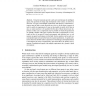Free Online Productivity Tools
i2Speak
i2Symbol
i2OCR
iTex2Img
iWeb2Print
iWeb2Shot
i2Type
iPdf2Split
iPdf2Merge
i2Bopomofo
i2Arabic
i2Style
i2Image
i2PDF
iLatex2Rtf
Sci2ools
93
Voted
MASA
2001
Springer
2001
Springer
Motivated Agent Behaviour and Requirements Applied to Virtual Emergencies
Virtual environments provide a rich and varied domain for intelligent agents, but questions of design and development in this context are still to be answered. An agent with multiple requirements and limited or constrained resources must be able to make decisions as to how to divide those resources in order to satisfy its requirements. It may not be possible to satisfy all of them at once, so some may have to be sacrificed for the sake of those that are more important; in other cases a compromise may be possible in which all requirements are partially satisfied. This paper examines the kinds of requirements we may expect to have of an agent in virtual environments, and describes how we can measure an agent’s preformance in this light. Such an analysis can be used as a conceptual design tool and as the basis of an agent specification. An agent architecture based on the BDI model is proposed in which design and implementation is decomposed in terms of requirements, and which allows ...
Related Content
| Added | 30 Jul 2010 |
| Updated | 30 Jul 2010 |
| Type | Conference |
| Year | 2001 |
| Where | MASA |
| Authors | Sorabain Wolfheart de Lioncourt, Michael Luck |
Comments (0)

